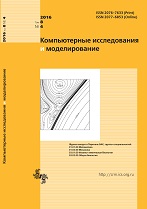|
This article is cited in 3 scientific papers (total in 3 papers)
ANALYSIS AND MODELING OF COMPLEX LIVING SYSTEMS
Some features of group dynamics in the resource-consumer agent model
N. V. Belotelova, I. A. Konovalenkob, V. M. Nazarovac, V. A. Zaycevd
a Dorodnicyn Computing Centre, Federal Research Center “Computer Science and Control”
of Russian Academy of Sciences,
40 Vavilova st., Moscow, 119333, Russia
b Moscow Institute of Physics and Technology (state university),
9 Institutsky Lane, Dolgoprudny, Moscow area, 141700, Russia
c Bauman Moscow State Technical University,
5/1 2-ya Baumanskaya st., Moscow, 105005, Russia
d A. N. Severtsov Institute of Ecology and Evolution, Russian Academy,
33 Leninsky Prosp., Moscow, 119071, Russia
Abstract:
The paper investigates the features of group dynamics of individuals-agents in the computer model of the animal population interacting with each other and with a renewable resource. This type of dynamics was previously found in [Belotelov, Konovalenko, 2016]. The model population consists of a set of individuals. Each individual is characterized by its mass, which is identified with energy. It describes in detail the dynamics of the energy balance of the individual. The habitat of the simulated population is a rectangular area where the resource grows evenly (grass).
Various computer experiments carried out with the model under different parameter values and initial conditions are described. The main purpose of these computational experiments was to study the group (herd) dynamics of individuals. It was found that in a fairly wide range of parameter values and with the introduction of spatial inhomogeneities of the area, the group type of behavior is preserved. The values of the model population parameters under which the regime of spatial oscillations of the population occurs were found numerically. Namely, in the model population periodically group (herd) behavior of animals is replaced by a uniform distribution over space, which after a certain number of bars again becomes a group. Numerical experiments on the preliminary analysis of the factors influencing the period of these solutions are carried out. It turned out that the leading parameters affecting the frequency and amplitude, as well as the number of groups are the mobility of individuals and the rate of recovery of the resource. Numerical experiments are carried out to study the influence of parameters determining the nonlocal interaction between individuals of the population on the group behavior. It was found that the modes of group behavior persist for a long time with the exclusion of fertility factors of individuals. It is confirmed that the nonlocality of interaction between individuals is leading in the formation of group behavior.
Keywords:
a computer model, cellular automata, spatial-temporal dynamics.
Received: 21.09.2018
Revised: 03.10.2018
Accepted: 15.10.2018
Citation:
N. V. Belotelov, I. A. Konovalenko, V. M. Nazarova, V. A. Zaycev, “Some features of group dynamics in the resource-consumer agent model”, Computer Research and Modeling, 10:6 (2018), 833–850
Linking options:
https://www.mathnet.ru/eng/crm688 https://www.mathnet.ru/eng/crm/v10/i6/p833
|

|



 Contact us:
Contact us: Terms of Use
Terms of Use
 Registration to the website
Registration to the website Logotypes
Logotypes